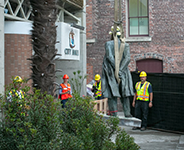Last year, Victoria’s mayor and council had the statue of Canada’s first prime minister, Sir John A. Macdonald, removed from City Hall and put into storage without any consultation from the citizens of Victoria.
That created quite an uproar.

On one side were people who applauded the removal due to the long history of oppression First Nation people experienced at the hands of the usurpers of their lands.
On the other side are the descendants of the usurpers who would like to see Sir John honoured for leading the vision of Canada as a new nation.
A far better course of action for Victoria council would have been to engender greater understanding and healing through conversation and discussion. The could have let Victoria know they were considering the removal or relocation of the statue and the reasons why as a way to shine a spotlight on the issue, then invite public discussion. The would have found most people are not insensitive to the feelings of First Nations. Rather, they are incensed by a council that thinks it knows best.
What will happen to the ignoble Sir John A now?
Will he find a place of respect in the B.C. Parliament Building or the Royal B.C. Museum? Will he be donated to Macdonald’s first family home in Kingston, Ontario – currently being renovated for $2.13 million? Or will he rot away in a storage closet, forever humbled by today’s political mores?
Victoria council could do a better job of honouring our history; the full story of our history, by returning the statue to Victoria City Hall and adding the First Nations perspective in the form of a statue or equivalent.
City politician’s urge to remove statues in order to try to right history’s wrongs continues.
In May, another statue of a now-controversial historical figure was removed from a B.C. public square; The province’s first chief justice, Judge Matthew Begbie.
New Westminster City council voted for the removal of the statue which was quietly taken off its stone pedestal outside the New Westminster provincial courthouse Saturday to cheers from local members of the Tsilhqot’in, Qayqayt and Squamish First Nations.
The main reason they cited for their decision was because Begbie oversaw the trial that found five Tsilhqot’in Nation chiefs guilty of murdering 14 members of a road-building crew in 1864. The chiefs were tricked into thinking they were meeting with the colonial government near Quesnel for peace talks.
Anyone would agree his actions in this case, especially the trickery, were abhorrent. It was a grave miscarriage of justice made by a flawed human being within an imperfect judicial system. Indeed, Begbie’s decisions were unappealable during the colonial period, which gave him greater power than any judge should have had.
Does that erase his positive contributions to our history?
Did you know he was not particularly susceptible to the opinions of the white majority? In 1860, Governor James Douglas had to deal with complaints that Begbie had allowed a white man to be convicted of assault at Yale “wholly on testimony from Indians.”
In several New Westminster cases, he let anger get the better of him, and that led to a lack of judiciousness. His actions weighed heavily on him through the years and he apologized when the city congratulated him for his knighthood in 1876. He said he had done things he was sorry for in those cases and asked their forgiveness.
His apology didn’t correct his judicial lapses, but it was an act of contrition today’s leaders could learn from. I’m thinking in particular of city councillors who believe they have the right to take down statues without public consultation.
Do their decisions make you angry?

